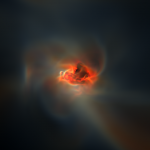
In late November, our paper, “The Birth of a Galaxy: Primordial Metal Enrichment and Stellar Populations”, was accepted for publication in The Astrophysical Journal. It was recently published in the January 20th issue.
In this paper, we followed the formation of over 300 Population III (metal-free) stars and accurately modeled the radiative feedback from their main sequence and studied the chemical enrichment from their supernovae. Our methods allowed us to follow a natural transition from Population III to Population II star formation, leading to the formation of 38 high-redshift dwarf galaxies with the most massive having M = 109 solar masses. We found that they produce a metallicity floor of 10-3 of solar metallicity in the vicinity (5-10 kpc) of their host halos. At redshift 7, about 14% of the cosmic mass is enriched above 10-6 of solar metallicity. This gives some clues on the origin of an observed metallicity floor of 10-3 in damped Lyman alpha absorbers.